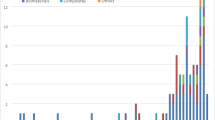Abstract
The objective of this effort was to extend the Bridgman analysis of tensile necking to obtain stress-strain data beyond the point of onset of necking from a split Hopkinson bar. For this purpose, combined analytical and experimental techniques were considered. The analytical efforts were focused on validating the use of Bridgman solutions for high rate of deformation through a finite-element analysis of a tapered tensile specimen. The experimental technique involved the development of a photographic system using a light-emitting diode and a 35-mm rotating drum camera for the observation of necking during dynamic tensile tests conducted with a split Hopkinson tension bar. The developed new technique was successfully used to measure neck profiles of 6061-T6 aluminum, HY100 and 1020 steel tensile specimens. The measured profiles were used with the Bridgman analysis and stress-strain data were obtained to over 70-percent strain.
Similar content being viewed by others
References
Considere, A., “L'Emploi du Fer et de L'Acier dans les Constructions,”Ann. Ponts Chaussees,9,574 (1885).
Bridgman, P.W., “Studies in Large Plastic Flow and Fracture,” Chap. 1, McGraw Hill (1952).
Norris, D.M., Moran, B., Schudder, J.K. andQuinones, D.F., “A Computer Simulation of the Tension Test,”J. Mech. Phys. Solids,26,1–19 (1978).
Needleman, A., J. Mech. Phys. Solids,20,111 (1972).
Chen, W.H., Int. J. Solids Struct.,7,685 (1971).
Hancock, H.W. andMcKenzie, A.C., “On the Mechanisms of Ductile Failure in High Strength Steels Subject to Multiaxial States of Stress,”J. Mech. Phys. Solids, 1, 2/3, 107 (1976).
Lindholm, U.S., “Some Experiments with the Split Hopkinson Pressure Bar,”J. Mech. Phys. Solids,12,317–335 (1964).
Nicholas, T., “Tensile Testing of Materials at High Rates of Strain,”Experimental Mechanics,21,177–185 (1981).
Brockman, R.A., “MAGNA: A Finite Element Program for the Materially and Geometrically Nonlinear Analysis of Three-Dimensional Structures Subjected to Static and Transient Loading,” AFWAL-TR-82-3098 (Dec. 1982).
Cross, L.A., Bless, S.J., Rajendran, A.M., Strader, E.A. andDawicke, D.S., “New Technique to Investigate Necking in a Tensile Hopkinson Bar,”Experimental Mechanics,24 (9),184–186 (Sept. 1984).
Rajendran, A.M., Bless, S.J. and Dawicke, D.S., “Evaluation of Bodner-Partom Model Parameters at High Strain Rate,” accepted for publication in J. Eng. Mat. & Tech., Trans. ASME (1985).
Hoggat, C.R. andRecht, R.F., “Stress-Strain Data Obtained at High Rates Using an Expanding Ring,”Experimental Mechanics,19 (10),441 (Oct. 1969).
Author information
Authors and Affiliations
Rights and permissions
About this article
Cite this article
Rajendran, A.M., Bless, S.J. Determination of tensile flow stress beyond necking at very high strain rate. Experimental Mechanics 26, 319–323 (1986). https://doi.org/10.1007/BF02320146
Received:
Revised:
Issue Date:
DOI: https://doi.org/10.1007/BF02320146




